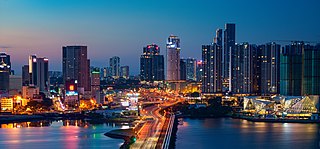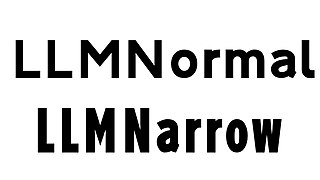The North–South Expressway is a network of tolled controlled-access highways running through the west coast of Peninsular Malaysia. The expressway network consists of the northern route and southern route, having a total length of 772 kilometres. Running through seven states and connecting the Thailand and Singapore borders, the North–South Expressway is an important thoroughfare for local, interstate and international traffic. The expressway is part of route AH2, a designation of the Asian Highway Network.
Skudai Highway(Lebuhraya Skudai), also known as Senai Highway, Jalan Tun Abdul Razak or Jalan Skudai, Federal Route 1, is a 29 kilometre partial-access highway in Johor, Malaysia, from the town of Senai in Kulai District to Johor Bahru City in Johor Bahru District. The highway is designated as part of Federal Route 1.
The East Coast Expressway is an interstate controlled-access highway running parallel to the northeastern coast of Peninsular Malaysia. The currently operational 433-kilometre (269-mile) segment of the expressway runs between Karak, Pahang and Kuala Nerus, Terengganu.

Malaysian Federal Roads System, is the main national road network in Malaysia. All Federal Roads in Malaysia are under the purview of the Ministry of Works (MOW). According to the Ministerial Functions Act 1969, the MOW is responsible to plan, build and maintain all Federal Roads gazetted under the Federal Roads Act 1959. However, most of the Federal roads' projects were built and maintained by the Malaysian Public Works Department (JKR), which is also one of the implementing agencies under the MOW.
The Federal Route 2 is a major east–west oriented federal highway in Malaysia. The 276.9 kilometres (172 mi) road connects Port Klang in Selangor to Kuantan Port in Pahang. The Federal Route 2 became the backbone of the road system linking the east and west coasts of Peninsula Malaysia before being surpassed by the East Coast Expressway E8.
Johor Bahru–Kota Tinggi Highway (Malay: Lebuhraya Johor Bahru–Kota Tinggi), Federal Route 3, also known as Tebrau Highway (Jalan Tebrau) and Jalan Kota Tinggi is a highway that encompasses Federal Route 3 in Johor Bahru, Malaysia. Part of Asian Highway Route AH18, the highway stretches from its southern end at Jalan Wong Ah Fook and Jalan Tun Abdul Razak in the metropolitan area of Johor Bahru to the northern end at the underpass flyover with North–South Expressway Southern Route and Johor Bahru Eastern Dispersal Link Expressway around Pandan. The stretch of Tebrau Highway after this continues as Jalan Pandan and Jalan Kota Tinggi respectively, beyond Pandan. The highway became the backbone of the Johor Bahru road system linking Pandan to the city centre, and to the Johor–Singapore Causeway, before being surpassed by the Johor Bahru Eastern Dispersal Link Expressway in 2012.
Federal Route 3 is a main federal road running along the east coast of Peninsula Malaysia. The 739 kilometres (459 mi) federal highway connects Rantau Panjang in Kelantan until Johor Bahru in Johor. The entire FT3 highway is gazetted as a part of the Asian Highway Network route 18.
Federal Route 5 is one of the three north–south oriented backbone federal road running along the west coast of Peninsular Malaysia, Malaysia. The 655.85 kilometres (408 mi) federal highway runs from Jelapang, Perak in the north to Skudai, Johor in the south.
The South Klang Valley Expressway, or SKVE South Klang Valley Expressway, is an expressway in the southern part of Klang Valley, Malaysia's most densely populated region. This 51.7 km (32.1 mi) dual-carriageway provides links to the booming towns in southern Klang Valley, including the country's administrative capital, Putrajaya. South Klang Valley Expressway is the fifth east–west-oriented expressway in the Klang Valley after the Federal Highway, the New Klang Valley Expressway (NKVE), the Kuala Lumpur–Kuala Selangor Expressway (LATAR) and the Shah Alam Expressway (KESAS).

Road signs in Malaysia are standardised road signs similar to those used in Europe but with certain distinctions. Until the early 1980s, Malaysia closely practice in road sign design, with diamond-shaped warning signs and circular restrictive signs to regulate traffic. Signs usually use the Transport Heavy font on non-tolled roads and highways. Tolled expressways signs use a font specially designed for the Malaysian Highway Authority (LLM) which is LLM Lettering. It has two type of typefaces, LLM Narrow and LLM Normal. Older road signs used the FHWA Series fonts typeface also used in the United States, Canada, and Australia.
A highway authority is a government organization responsible for public roads.
Motorcycle lane is a term used for the special lane on a roadway that is designated for small vehicles such as motorcycles, scooters, bicycles and trishaw. It's usually situated between the other lanes, marked by 2 parallel yellow lines. Due to the popularity of such vehicles in several Asian countries, motorcycle lanes are commonly found there.
Ipoh–Lumut Highway, Federal Route 5, is a 70.7-km federal highway in Perak, Malaysia, connecting the Perakian capital city of Ipoh in the east to Lumut near Sitiawan in the west. The Ipoh–Lumut Highway consists of a 22.7-km super two highway from Jelapang to Seputeh and a 48-km divided highway from Seputeh to Lumut. This highway is a part of the Federal Route 5 and serves as the final section of the FT5 route.
Gebeng Bypass, Federal Route 101, AH141, is a highway bypass connecting Jabur, Terengganu to Gebeng near Kuantan Port, Pahang, Malaysia.

Teras Teknologi Sdn Bhd (TERAS), a subsidiary of PLUS Malaysia Berhad (PMB), is a Malaysian global corporation based in Petaling Jaya.
The Kuala Lumpur–Karak Expressway East Coast Expressway is a 60-kilometre (37 mi) interstate controlled-access highway in Peninsular Malaysia. It runs between the town of Gombak in Selangor to the southwest and Karak in Pahang to the northeast. The expressway was previously a single-carriageway trunk road forming part of federal route 2; this designation is kept after the upgrade in 1997.

Iskandar Malaysia, formerly known as Iskandar Development Region (IDR; Malay: Wilayah Pembangunan Iskandar) and South Johor Economic Region (SJER), is the main southern development corridor in Johor, Malaysia. It was established on 8 November 2006. Iskandar Malaysia, which is formed by major cities such as Johor Bahru, Iskandar Puteri and Pasir Gudang, also lies within the original Indonesia–Malaysia–Singapore growth triangle, along with Singapore and Riau, Indonesia.

The Malaysian Expressway System is a network of national controlled-access expressways in Malaysia that forms the primary backbone network of Malaysian national highways. The network begins with the Tanjung Malim–Slim River tolled road which was opened to traffic on 16 March 1966, later North–South Expressway (NSE), and is being substantially developed. Malaysian expressways are built by private companies under the supervision of the government highway authority, Malaysian Highway Authority.

LLM Lettering is a set of sans-serif typefaces developed by the Malaysian Highway Authority and used for road signage on expressways in Malaysia. The font was divided into two types: LLM Normal (Standard/Regular) and LLM Narrow (Condensed). The LLM Normal typeface is a modified form of the Italian Alfabeto Normale and Alfabeto Stretto. The lettering is special use for the Malaysian Expressway System.







